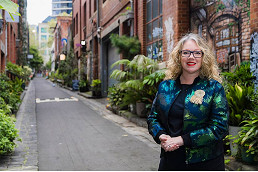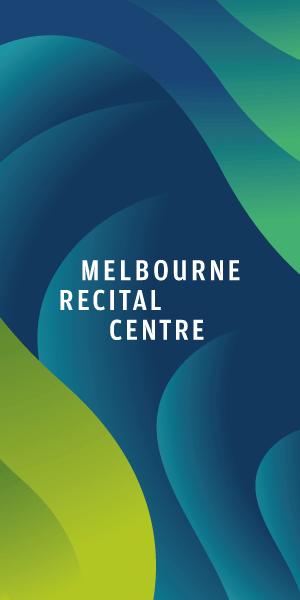Mrs Purnell’s Hotel – a small feminist statement of the 1860s
It may not seem it, but the modest façade of Mrs Purnell’s Hotel at 12 Bourke St is a symbol of one man’s failure and his wife’s strength in providing financial security for herself and her family.
It represents the outcomes of their failed family life. When this photograph from the Royal Historical Society’s images collection was taken in about 1868, Margaret Purnell had just become the licensee and Thomas Purnell had been gone from the scene for four years, leaving the future of their family in his wife’s hands.
The hotel was home to Mrs Purnell and her five children for the following two years. To understand how they got there it is necessary to go back to the days before self-government, when Melbourne was part of the Port Phillip District of New South Wales, before the gold rush transformed Victorian society.
Thomas and Margaret Purnell married in Melbourne in 1846, just over a decade after the first settlers, the “land-takers” as historian Michael Cannon dubbed them, had dispossessed the traditional owners of the land.
The Purnells were the next generation of settlers, incomers who arrived after the settlement had established itself and was coming out the other side of a potentially catastrophic economic depression. Melbourne had settled into more than Batman’s “village”. The Hoddle Grid had been set out. The first land sales were a distant memory and the vast tent city set up on the south of the Yarra had given way to more substantial buildings.
Thomas Purnell set up business as an Elizabeth St cooper in 1847. He made his mark early, the Port Phillip Gazette in July that year reporting that he had just completed the largest ale vat ever built in the Port Phillip District, a vat capable of holding 6000 gallons (nearly 23,000 litres).
With the discovery of gold, Thomas saw his opportunity to expand and prosper, and opened a wine and spirit store alongside his Elizabeth St cooperage. By 1853 the family had moved to Great Bourke St (we know it simply as Bourke St) where another child was born. In the following year, Purnell made his debut as a publican when he became the licensee of the Plough Inn in Bourke St. By then he and his wife were in their mid-30s and the parents of five young children (another three were born during their time at the Plough Inn). The hotel was their home as well as their workplace.
Thomas Purnell expanded his business interests, opening a soda water manufactory and investing in a 20-acre block of land with a substantial two storey house and four-acre garden in Orrong Rd, Caulfield. His seeming prosperity soon evaporated, however. He sold the soda water business within twelve months of purchase, then the lease on his cooperage. He relinquished the lease on the Plough Inn, although he later returned to it, and he attempted to sell his Caulfield property. Disaster struck at home, too, two young daughters dying within a few months of each other.
In May 1864 Purnell was declared insolvent and left the colony. Margaret and the children (the youngest just three years old) were left to fend for themselves.
And here we are, four years later, at Mrs Purnell’s Hotel. What she did in the intervening years is not known, but in June 1868 she applied for the licence of this hotel, noting that there would be two sitting rooms and two bedrooms, as well as those “required for the use of my family.” That family consisted of four children aged 7 to 21.
This was a short-lived moment, however, and by 1871 Mrs Purnell and children had moved to the Meat Market Hotel in Hotham (North Melbourne). Her daughter, Margaret, a teacher, was working in Bendigo, but her other children were still at home with her. She remained there until the year before her death when she went to live with her daughter Margaret, by then the Principal of Carlton Ladies’ College. She died at her daughter’s home just before Christmas 1875 aged 55.
Margaret Purnell showed strength of character in the years after her husband’s departure. She had kept her family together after their financial disasters in the 1860s. She had run her own hotels for almost a decade. She had survived.
Little is known about her children’s lives, except for her daughter Margaret, the teacher, who by her middle 20s was running her own successful school in Carlton. After her mother’s death Margaret ventured to New Zealand where she was impressed by the women’s suffrage movement. She returned to Melbourne where in the mid-1890s she hosted meetings of the Women’s Social and Political Reform League and employed feminist and political activist Bella Guerin O’Halloran on her teaching staff.
As you look at this image of Mrs Purnell’s modest hotel, you will have noticed the men, some in workmen’s clothing, posing outside the building, but did you notice the woman standing in the doorway partly obscured by the men? In all probability this is Mrs Purnell herself. I can imagine, too, her 18-year-old daughter Margaret inside, perhaps behind the open window on the upper floor with lace curtains flapping in the breeze. Well educated, newly matriculated and having passed the civil service examinations, was she now dreaming of and planning for the possibilities of the life ahead of her, possibilities made possible by the efforts of her mother, who chose to remain in the hotel trade, one of the few workplaces that allowed her to raise her family and earn a living without leaving home? •

Could the Metro Tunnel help Melbourne rediscover its mojo?




 Download the Latest Edition
Download the Latest Edition